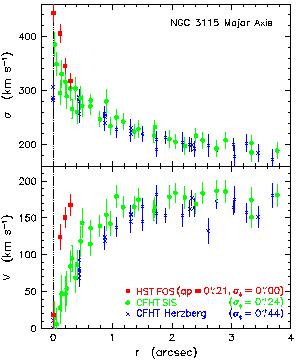


3.2 NGC 3115: MBH
 109.0 ± 0.3
M
109.0 ± 0.3
M
One of the best stellar-dynamical BH cases is the prototypical S0 galaxy NGC 3115 (Fig. 1). It is especially suitable for the BH search because it is very symmetrical and almost exactly edge-on. NGC 3115 provides a good illustration of how the BH search makes progress. Unlike some discoveries, finding a supermassive BH is rarely a unique event. Rather, an initial dynamical case for a central dark object gets stronger as observations improve. Eventually, the case becomes definitive. This has happened in NGC 3115 through the study of the central star cluster - a tiny, dense cusp of stars like those expected around a BH (Figure 1). Later, still better observations may accomplish the next step, which is to strengthen astrophysical constraints enough so that all plausible BH alternatives (clusters of dark stars) are eliminated. This has happened for our Galaxy (Section 3.4) but not yet for NGC 3115.

|
Figure 1. HST WFPC2 images of NGC 3115. The left panel shows a color image made from 1050 s V- and I-band images. The right panel shows a model of the nuclear disk. The center panel shows the difference; it emphasizes the compact nuclear star cluster. Brightness is proportional to the square root of intensity. All panels are 11".6 square. [This figure is taken from Kormendy et al. 1996, Astrophys. J. Lett., 459, L57.] |
The kinematics of NGC 3115 show the signature of a central dark object
(Fig. 2). The original detection was based on
the blue crosses. Already
at resolution  * =
0".44, the central kinematic gradients are steep.
The apparent central dispersion,
* =
0".44, the central kinematic gradients are steep.
The apparent central dispersion, 
 300 km s-1, is
much higher than normal for a galaxy of absolute magnitude
MB = -20.0.
Therefore, isotropic dynamical models imply that NGC 3115 contains a dark mass
MBH
300 km s-1, is
much higher than normal for a galaxy of absolute magnitude
MB = -20.0.
Therefore, isotropic dynamical models imply that NGC 3115 contains a dark mass
MBH  109
± 0.3
M
109
± 0.3
M . Maximally
anisotropic models allow
smaller masses, MBH ~ 108
M
. Maximally
anisotropic models allow
smaller masses, MBH ~ 108
M , but isotropy
is more likely given the rapid rotation.
, but isotropy
is more likely given the rapid rotation.

|
Figure 2. Rotation velocities (lower panel)
and velocity dispersions
(upper panel) along the major axis of NGC 3115 as observed at three different
spatial resolutions. Resolution
|
Since that time, two generations of improved observations have become
available. The green points in Figure 2 were
obtained with the Subarcsecond
Imaging Spectrograph (SIS) and the Canada-France-Hawaii Telescope (CFHT). This
incorporates tip-tilt optics to improve the atmospheric PSF. The observations
with the HST Faint Object Spectrograph (FOS) have still higher
resolution. If the BH detection is correct, then the apparent rotation and
dispersion profiles should look steeper when they are observed at higher
resolution. This is exactly what is observed. If the original dynamical
models are ``reobserved'' at the improved resolution, the
ones that agree with the new data have
MBH = (1 to 2) x 109
M .}
.}
Finally, a definitive detection is provided by the HST observations
of the nuclear star cluster. Its true velocity dispersion is underestimated in
Figure 2, because the projected value includes
bulge light from in front of and
behind the center. When this light is subtracted, the velocity
dispersion of the
nuclear cluster proves to be  =
600 ± 37 km s-1. This is the
highest dispersion measured in any galactic center. The velocity of escape from
the nucleus would be much smaller, Vesc
=
600 ± 37 km s-1. This is the
highest dispersion measured in any galactic center. The velocity of escape from
the nucleus would be much smaller, Vesc
 352 km s-1, if it
consisted only of stars. Without extra mass to bind it, the cluster would fling
itself apart in ~ 2 x 104 yr. Independent of any velocity
anisotropy, the nucleus must contain an unseen object of mass
MBH
352 km s-1, if it
consisted only of stars. Without extra mass to bind it, the cluster would fling
itself apart in ~ 2 x 104 yr. Independent of any velocity
anisotropy, the nucleus must contain an unseen object of mass
MBH
 109
M
109
M .
This is consistent with the modeling results. The dark object is more than 25
times as massive as the visible star cluster. We know of no way to make a star
cluster that is so nearly dark, especially without overenriching the visible
stars with heavy elements. The most plausible explanation is a BH. This would
easily have been massive enough to power a quasar.
.
This is consistent with the modeling results. The dark object is more than 25
times as massive as the visible star cluster. We know of no way to make a star
cluster that is so nearly dark, especially without overenriching the visible
stars with heavy elements. The most plausible explanation is a BH. This would
easily have been massive enough to power a quasar.